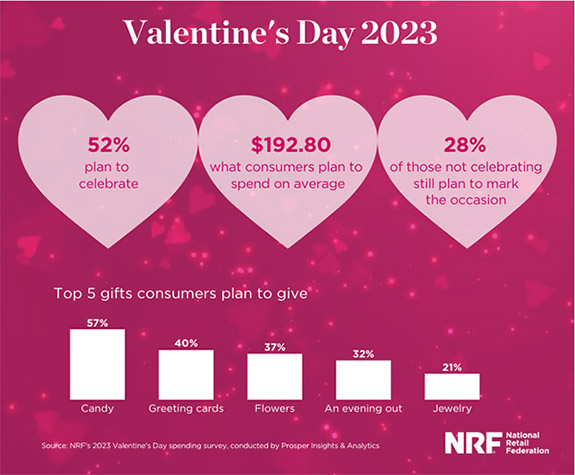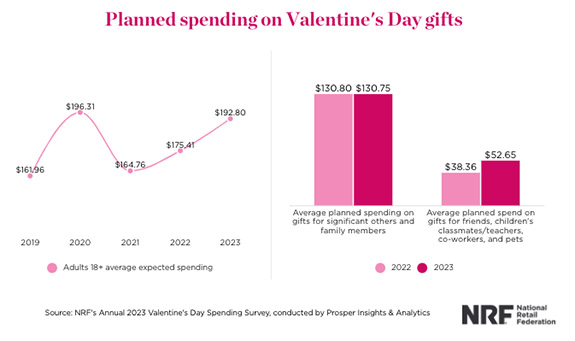For the seventh year in a row, the National Retail Federation is predicting that Valentine's Day shoppers will spend more on jewelry gifts than any other category. Jewelry purchases are expected to top $5.5 billion in 2023, outperforming the second-strongest category — "an evening out" — by $1.1 billion.
Overall Valentine's Day spending is estimated to reach $25.9 billion this year, an increase of $2 billion compared to 2022.
Jewelry-related purchasing will account for 21.2% of all dollars spent on Cupid's favorite holiday. Although jewelry remained the strongest category (in dollars), the category's share of the pie notched down from 25.9% in 2022. That surprisingly high percentage was somewhat of an anomaly because many consumers chose not to spend on "experiential" activities due to concerns related to the pandemic. In fact, jewelry's 21.2% share is higher than it was in 2021 (18.8%).
In the survey conducted by the NRF and Prosper Insights & Analytics, exactly 21% of respondents said they will gift a jewelry item to a special someone, while “gifts of experience,” such as an evening out or tickets to a concert or sporting event, reached a seven-year high of 32%.
More than half (52%) of US consumers plan to celebrate Valentine’s Day in 2023 with average spending reaching $192.80, up from $175.41 per person in 2022. It's the second-highest amount recorded since NRF and Prosper began tracking this data back in 2004.
“Valentine’s Day is a special occasion to shop for the people we care most about,” NRF President and CEO Matthew Shay said. “This year, as consumers embrace spending on friends and loved ones, retailers are ready to help customers celebrate Valentine’s Day with memorable gifts at affordable prices.”
Other popular, but less expensive, Valentine gifts include candy (to be given by 57%), greeting cards (40%), flowers (37%), and gift cards (20%).
Even the 28% of those who don’t plan to celebrate Valentine’s Day will still mark the occasion with a special non-Valentine themed treat or an evening with friends and family, according to the NRF.
The survey of 7,616 U.S. adult consumers was conducted January 3-11 and has a margin of error of plus or minus 1.1 percentage points.
Credits: Image by BigStockPhoto.com. Charts courtesy of the National Retail Federation.



No comments:
Post a Comment